
Styphelia sieberi, commonly known as prickly beard-heath, is a species of flowering plant in the heath family Ericaceae and is endemic to south-eastern continental Australia. It is an erect, densely-branched shrub with oblong to more or less egg-shaped leaves with the narrower end towards the base, and white, tube-shaped flowers arranged singly in upper leaf axils.

Styphelia ericoides, commonly known as the pink beard-heath, is a species of flowering plant in the heath family Ericaceae and is endemic to south-eastern Australia. It is a slender shrub with oblong leaves, and white to pinkish, tube-shaped flowers.

Lissanthe strigosa, commonly known as peach heath, is a species of flowering plant in the family Ericaceae, and is endemic to south-eastern Australia. It is a shrub with linear to lance-shaped leaves and white to pink, cylindrical flowers.

Styphelia fletcheri is a species of flowering plant in the heath family Ericaceae and is endemic to south-eastern continental Australia. It is a densely-branched shrub with sharply-pointed oblong leaves, and pendent, tube-shaped white flowers in pairs in upper leaf axils.

Styphelia perileuca, commonly known as montane green five-corners, is a plant in the heath family Ericaceae and is endemic to New South Wales. It is an erect, spreading shrub with broad leaves with a spiky tip, and yellowish-green and red tube-shaped flowers with the petals rolled back. It is only known from the eastern edge of the New England Tableland.
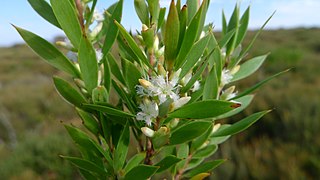
Styphelia esquamata, commonly known as the swamp beard-heath, is a species of flowering plant in the heath family Ericaceae and is endemic to south-eastern Australia. It is a slender shrub with mainly elliptic leaves, and short-lived white, tube-shaped flowers arranged singly or in pairs in upper leaf axils.
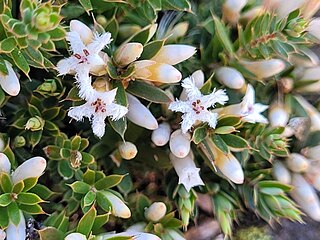
Styphelia nesophila, commonly known as sharp beard-heath, is a species of flowering plant in the heath family Ericaceae and is native to south-eastern Australia and New Zealand, where it is known as pātōtara, or dwarf mingimingi. It is a prickly, prostrate to trailing or low-growing shrub with egg-shaped leaves, and erect, tube-shaped white flowers usually arranged singly in leaf axils.

Prostanthera oleoides is a species of flowering plant that is endemic to central Queensland. It is an open, erect shrub with four-sided branchlets, narrow elliptic, oblong or egg-shaped leaves with the narrower end towards the base, and mauve flowers with purple to dark mauve markings.
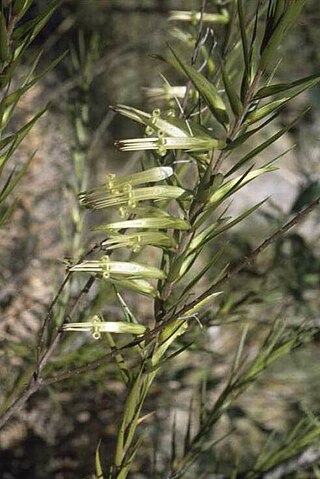
Styphelia longifolia, commonly known as long-leaf styphelia, is a species of flowering plant in the heath family Ericaceae and is endemic to New South Wales. It is an erect shrub with more or less lance-shaped leaves and pale green or yellow flowers arranged singly in leaf axils.
Bossiaea milesiae is a species of flowering plant in the family Fabaceae and is endemic to a restricted area of New South Wales. It is an erect shrub with flattened, winged cladodes, small, scale-like leaves, and pea-like yellow to apricot-coloured and red flowers.

Styphelia biflora is a species of flowering plant in the heath family Ericaceae and is endemic to eastern Australia. It is an erect to spreading shrub with hairy branchlets, oblong leaves and small white flowers.

Styphelia deformis is a species of flowering plant in the heath family Ericaceae and is endemic to eastern coastal Australia. It is a bushy shrub with narrowly egg-shaped leaves, and white, tube-shaped flowers.
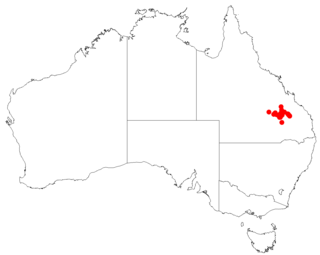
Styphelia grandiflora is a species of flowering plant in the heath family Ericaceae and is endemic to Carnarvon National Park in south-eastern Queensland. It is a shrub with softly-hairy branchlets, oblong leaves and white flowers.
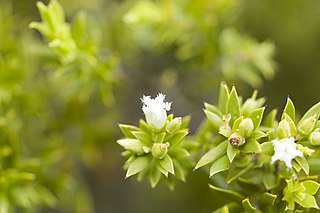
Styphelia leptospermoides is a species of flowering plant in the heath family Ericaceae and is endemic to eastern Australia. It is an erect, bushy shrub with elliptic to lance-shaped or oblong leaves, and white, tube-shaped flowers usually arranged singly in upper leaf axils.

Styphelia margarodes is a species of flowering plant in the heath family Ericaceae and is endemic to near-coastal areas of eastern Australia. It is an erect, spreading shrub with egg-shaped leaves with the narrower end towards the base, and small numbers of white, tube-shaped flowers usually arranged singly or in pairs in upper leaf axils.

Leucopogon virgatus, commonly known as common beard-heath, is a species of flowering plant in the heath family Ericaceae and is endemic to south-eastern Australia. It is an erect to low-lying shrub with linear to narrowly lance-shaped or egg-shaped leaves, and erect clusters of three to seven white, tube-shaped flowers on the ends of branches and in upper leaf axils.

Styphelia angustifolia is a species of flowering plant in the heath family Ericaceae and is endemic to eastern New South Wales. It is an erect shrub with lance-shaped to narrowly egg-shaped leaves and pale green, pendent flowers in summer.

Styphelia kingiana is a species of flowering plant in the heath family Ericaceae and is endemic to the south-west of Western Australia. It is an erect, compact shrub with sharply pointed, egg-shaped leaves, and white, tube-shaped flowers arranged in clusters near the ends of branchlets.

Styphelia laeta, commonly known as five corners, is a species of flowering plant in the heath family Ericaceae and is endemic to New South Wales. It is a slender, erect shrub with broadly elliptic or egg-shaped leaves and pale yellowish-green or red flowers arranged singly in leaf axils.

Lissanthe rubicunda is a species of flowering plant in the family Ericaceae and is endemic to the south of Western Australia. It is a slender, erect to spreading shrub with few branches and sharply-pointed linear leaves and short spikes or racemes of red, tube-shaped flowers.



















